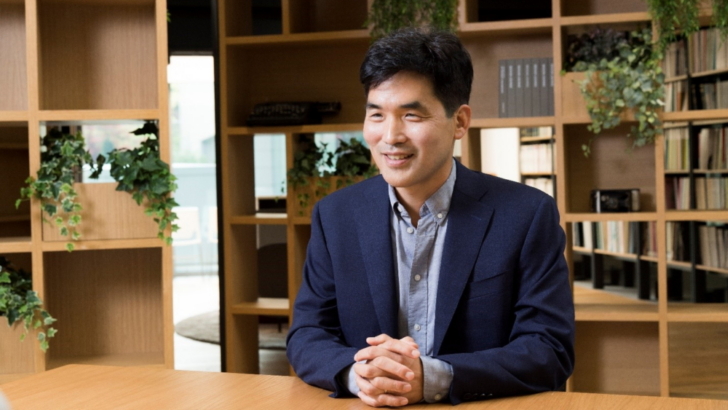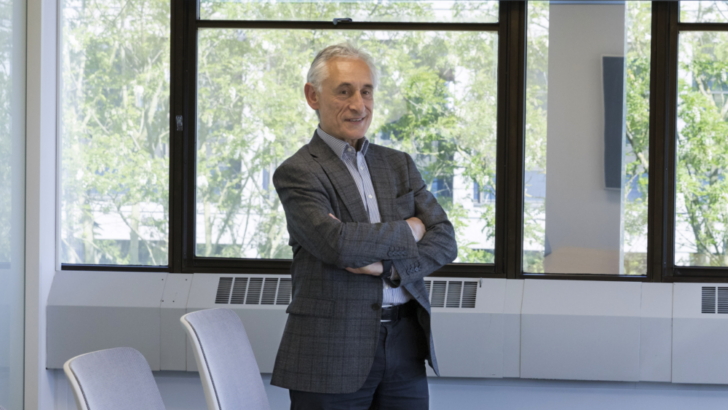[Hearing from an AI Expert – 5] At the Intersection of Robotics and Innovation
on October 18, 2019

There is much anticipation these days around the field of robotics with its immense potential and promising future applications. However, a large gap exists between public expectations and what is actually deemed technically feasible by scientists and engineers today. Fortunately, Samsung’s New York AI Center is buoyed by the presence of a team of highly skilled researchers, led by robotics and AI expert Dr. Daniel D. Lee, who are working to close this gap. Samsung Newsroom spoke with Dr. Lee about the work being done at the center, as well as the facility’s ability to foster collaboration in a range of areas and attract top talent.
Challenges to Overcome
Asked about his center’s mandate, Lee explains that the New York AI Center focuses on “fundamental research at the intersection of AI, robotics and neuroscience.” The center’s objective is to “solve challenging problems” at this intersection, and one good example is the problem of robotic manipulation1.
Put simply, robots need to become far more skillful before they are ready to help humans with physical tasks in their daily lives. The first step involves endowing robots with the intelligence to perceive and understand their surroundings. Next, they must be able to make swift decisions in unpredictable situations. Finally, robots should be dexterous and nimble enough to perform the appropriate actions. However, it is impossible for robot designers to anticipate every contingency robots will encounter in real world environments. Thus, robots need to be able to learn from experience just as humans do.
At this time, most common machine learning methods are not suitable for teaching robots since enormous amounts of training data are required. Lee explained that there are several challenges that need to be addressed regarding machine learning for robotics.
“Dealing with the physical world is much more difficult for AI than playing video games or Go,” he explains, “We are currently developing AI learning methods that can deal with the uncertainty and diversity of the physical world so that robots become more prevalent in homes and workplaces. I would compare the state of robots today to computers in the 1980’s during the transformation from mainframes to personal computers.”
The New York AI Center is addressing such challenges to provide a richer AI and robotics experience. For instance, the center has recently developed novel AI methods that are able to efficiently teach robots using limited data. One recently-developed method trains a neural network to generate motion trajectories for a robot arm directly from camera images.
Getting a Handle on Robotic Manipulation
In order to allow robots to handle things for people, robots need to learn how to touch, grasp, and move a variety of everyday objects. Lee explains how the problem of dexterous robotic manipulation is an area of focus for the New York AI Center.
Lee comments that “the ability of humans and some animals to manipulate household objects is currently unmatched by machines. That’s why we are investigating how AI-based solutions can be applied to make breakthroughs in this area.” Extrapolating further, Lee explains that ‘dexterous’ robotic manipulation “requires the ability to precisely and robustly handle objects exhibiting uncertain material properties.”
“Manipulation is relatively easy if the objects and environments are carefully controlled, such as on a factory floor,” Lee reports, “But it becomes much more difficult in unknown, cluttered environments when faced with a diverse array of objects.”
By way of an example, Lee lays out the capabilities that would be required for a robot to serve a chilled glass of wine in a restaurant. “How heavy is the glass, and how slippery is it due to condensation?” He adds, “It’s impossible to completely model all the possible physical characteristics of the glass of wine, so machine learning is critical in training robots to handle the difficult situations.”
Collaborative Innovation
As the AI sector has grown more sophisticated, it has become increasingly clear that collaborative solutions are critical for researchers to overcome the challenges they face. In an area as complex and multi-faceted as robotic manipulation, contributions from and collaborations with “the world’s best and brightest” will be instrumental, comments Lee. He highlights the value of working with both other Samsung AI Centers and academic institutions, saying that, “solving fundamental problems in AI to positively impact society requires drawing upon the ability and skills of numerous experts globally.”
He added, “The Samsung AI Centers invite collaborations with researchers who can help address these difficult challenges. We currently have a number of faculty from leading academic institutions who are collaborating with us in New York.”
Attracting Talent
Lee highlights just how beneficial being located in New York has been for his team, saying that “certainly, New York City is one of the greatest and most diverse cities in the world. It is a magnet for world-class research and engineering talent.”
Attracting the very best in talent is extremely important to remain on the bleeding edge of future AI advancements, and Lee reports that the center has been fortunate in this area, saying, “We have benefited from being able to attract and recruit some outstanding researchers since we started the Center.”
“Our team is composed of expert scientists and engineers who are creating innovative theories and algorithms and state-of-the-art technological developments,” Lee adds, “It’s been great working with them to publish in leading academic conferences and journals as well.”

How Robotics Could Revolutionize Our Lives
Speaking about how he envisions robots will fit into society in the future, Lee points out that, in their infancy, some robots drew attention because they were cute and fun, but that people tended to use them less as the novelty wore off. In order for people to see robots as valuable and relevant, new systems need to have enough intelligence that they become indispensable in our daily lives.
“Intelligent robotic systems have the potential to completely revolutionize how people go about their activities in the future,” Lee extrapolates, “In the near term, we will see modest improvements on simple tasks in constrained environments. But more complete systems that can handle a variety of chores and complex tasks will require further research breakthroughs. The Samsung AI Centers are helping to generate those new advances.”
Asked to outline what he sees as the ultimate vision for AI and robotic intelligence, Lee says, “I grew up reading and watching science fiction stories that envisaged amazing robots helping humans. It would be incredible to see some of those positive visions actually come to life.”
1 The ability for robots to interact with and move physical objects in a range of environments.





